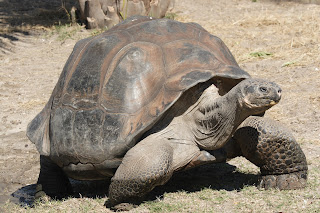
The Galapagos tortoise is the world’s largest tortoise. This stunning animal can only be found on the Galapagos Islands. Only 11 of the 15 known subspecies of Galapagos tortoises remain in the wild. They can live in a variety of environments, from dry lowlands to humid highlands. Sailors and whale hunters hunted Galapagos tortoises in large numbers during the 17th, 18th, and 19th centuries for their meat. As a result, several subspecies became extinct, and the number of subspecies that survived decreased dramatically. The Galapagos tortoises are all classified as endangered.
Galapagos tortoises are the largest tortoises, reaching 4 feet in length and weighing 475 pounds.
Galapagos tortoises have a brown, protective shell that wraps around their bodies. The carapace is the upper side of the shell.
The plastron is the lower part of the shell.
Their shell is an essential component of their skeleton (it cannot be removed from the rest of the body). When threatened, tortoises can pull their heads and legs inside their shells.
The Galapagos tortoise has stumpy feet with scaly skin. They have powerful jaws but no teeth.
Galapagos tortoises that live in drier areas have saddle-shaped shells that allow them to stretch their necks and grab vegetation that grows above ground, such as vines, leaves, and fruit.
Galapagos tortoises that live in colder climates have a dome-shaped shell that prevents neck stretching.
They eat grass by grazing on it.
The Galapagos tortoise, unlike any other animal, can survive for up to a year without food or water.
Tortoises from the Galapagos Islands move slowly. They have a top speed of 0.18 miles per hour and can travel long distances.
The Galapagos tortoises are cold-blooded creatures (they do not have stable body temperature). As a result, Galapagos tortoises enjoy sunbathing.
The Galapagos Islands got their name from these tortoises. When the first Spanish sailors arrived on the island, they discovered a plethora of tortoises. Because the tortoise is known as “Galapago” in Spanish, the entire island is known as Galapagos Island.
Aside from humans, the natural predators of Galapagos tortoises are hawks that eat eggs and young tortoises. Introduced species such as pigs, cats, dogs, and rats reduce the number of eggs in the wild as well.
Mating season occurs from January to March, during the rainy season.
Female travels several kilometers to find suitable habitat for egg laying. In the underground nest, she lays between 2 and 16 eggs. After 4 to 8 months, the eggs will hatch. Galapagos tortoises do not exhibit parental care, and young tortoises are left alone.
Because of the abundance of predators, only a small percentage of hatchlings survive to adulthood. Galapagos tortoises reach sexual maturity between the ages of 20 and 25.
Galapagos tortoises can live in the wild for more than 100 years.









